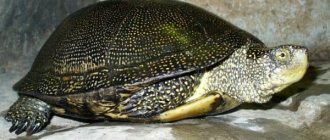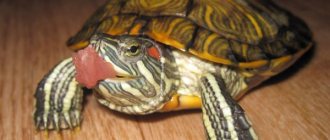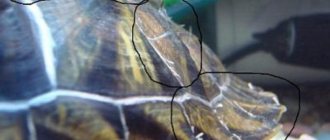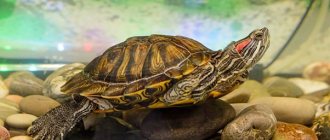There are several different species of red-eared turtles, which vary in size. They are not difficult to keep at home, but some species require organization of sleep and in this regard, the owners have a number of questions:
- Does a red-eared turtle need hibernation if it is not in natural conditions?
- Why do they hibernate?
- What needs to be done to prevent the turtle from falling asleep?
- What is the function of hibernation for turtles?
- What is the red-eared slider's sleep period?
Turtle hibernation (wintering)
In nature, when it gets too hot or too cold, turtles go into summer or winter hibernation.
The turtle digs a hole in the ground, where it crawls and sleeps until the temperature changes. In nature, hibernation lasts approximately 4-6 months, at least from December to March. The turtle begins to prepare for hibernation when the temperature in its habitat remains below 17-18 C for a long time, and when it exceeds these values for a long time, it’s time for the turtle to wake up. At home, it is very difficult to hibernate correctly so that the turtle emerges healthy and at all, so if you are new to terrariums, we recommend that you do not hibernate turtles. Sick animals and those recently brought from elsewhere are definitely not allowed to hibernate.
The advantages of wintering: it helps maintain normal activity of the thyroid gland and thereby increase the life expectancy of the turtle; it synchronizes the sexual activity of males and follicular growth of females; it prevents excess growth and helps maintain normal hormonal status. Both land and freshwater turtles can be hibernated.
Disadvantages of wintering: the turtle may die or wake up sick.
What mistakes happen when organizing wintering
- Sick or weakened turtles are put to winter
- Humidity too low during hibernation
- Temperature too low or too high
- Insects that climbed into the wintering container and damaged the turtle
- You woke up turtles during hibernation and then put them back to sleep
How to avoid wintering
In mid-autumn, turtles, which in nature become less active during the winter, refuse food. If you do not want the turtle to hibernate and cannot provide it with normal sleeping conditions, then increase the temperature in the terrarium to 32 degrees and bathe the turtle more often. If the turtle won’t eat, then you should go to the veterinarian and get a vitamin injection (Eleovita, for example).
How to put a turtle to sleep
European keepers strongly recommend hibernating turtles for their health. However, in apartment conditions this is not at all easy to do. It is much easier to hibernate reptiles for those who have a private home. If, nevertheless, your goal is to put the turtle to sleep, or the turtle itself wants to go into hibernation (it often sits in the corner, digging soil), then:
- Make sure the turtle is a species that overwinters in the wild, so clearly identify its species and subspecies.
- You need to be sure that the turtle is healthy. It is better to consult a veterinarian. However, it is not recommended to give vitamins and fertilizers immediately before wintering.
- Before hibernation (late autumn, early winter), the turtle must be well fed so that it gains a sufficient amount of fat necessary for nutrition during sleep. In addition, the turtle should drink more.
- A land turtle is bathed in warm water, then not fed for several weeks, but given water so that all the food eaten is digested (small ones for 1-2 weeks, large ones for 2-3 weeks). Freshwater turtles have their water levels lowered and are also not fed for a couple of weeks.
- Gradually reduce the duration of daylight hours (by moving the timer to shorter periods of turning on the lamps) and temperatures (gradually turn off the lamps or water heating) with increasing humidity to the level required during the cooling period. The temperature must be lowered gradually, since reducing it too sharply will lead to colds.
- We prepare a wintering box, which should not be too large, because... During hibernation, turtles are inactive. A plastic container with air holes will do. Wet sand, peat, and sphagnum moss 10-30 cm thick are placed at the bottom. The turtles are placed in this box and covered with dry leaves or hay on top. The humidity of the substrate in which the turtle overwinters should be quite high (but the substrate should not get wet). You can also place turtles in linen bags and pack them in foam boxes, in which sphagnum or sawdust will be loosely scattered.
- Leave the container at room temperature for 2 days.
- We place the container in a cool place, for example, in a corridor, preferably on a tile, but so that there are no drafts.
- IN
depending on the type and the temperatures it requires, we lower the temperature, For example: floor (18 C) for 2 days -> on the windowsill (15 C) for 2 days -> on the balcony (12 C) for 2 days -> in the refrigerator (9 C) for 2 months. The wintering place for the turtle should be dark, well ventilated, and have a temperature of 6-12°C (preferably 8°C). For exotic southern tortoises, lowering the temperature a couple of degrees may be sufficient. Every time you examine the turtle, you need to spray the soil with water. It is better to do this once every 3-5 days. For aquatic turtles, humidity during hibernation should be greater than for land turtles.
- It is necessary to bring them out of hibernation in the reverse order. Before overwintering turtles are allowed into a terrarium or outdoor area, they are bathed in warm water. If the turtle appears dehydrated, emaciated, inactive, or in a daze, restorative measures should begin with warm baths.
- Normally, the turtle should start feeding within 5-7 days after the temperature reaches normal. If the turtle is unable to recover, you should contact a veterinarian.
It is important to know
Hibernation time for turtles is usually 8-10 weeks for small turtles and 12-14 for large turtles. Turtles should be placed in winter quarters in such a way that they “wake up” no earlier than February, when daylight hours noticeably lengthen. Can be from 3-4 weeks to 3-4 months. The condition of the turtles is checked every month, trying not to disturb them. The weight of a turtle normally decreases by 1% for each month of wintering. If the weight decreases faster (more than 10% of the weight) or the general condition worsens, wintering must be stopped. During the winter, it is better not to bathe turtles, as they usually urinate if they feel water getting on their shell. If the turtle begins to be active at a temperature of 11-12°C, wintering should also be stopped. For all hibernating reptiles, the limits of temperature fluctuations are from +1°C to +12°C; In case of long-term cooling below 0°C, death occurs.
(author of some of the information is Snegir, forum myreptile.ru)
Gentle hibernation regime for turtles
If the general condition of the turtle does not allow for a full winter, or if there are no suitable conditions in the apartment, you can arrange “overwintering” in a gentle manner. To do this, soil that better retains moisture (sawdust, moss, peat, dry leaves, etc.) is added to the terrarium in which the turtle was kept. Level - 5 - 10 cm. The soil should not get wet. The light in the terrarium can be turned on for 2 - 3 hours a day. In the middle of overwintering, the lights can be turned off completely for 2 - 3 weeks. The temperature should be maintained at 18 -24°C during the day, and drop to 14 - 16°C at night. After the “peak” of such wintering (when the heating is turned on again for 2 - 3 hours), you can offer the turtle her favorite food once a week. The beginning of independent feeding is a signal of the end of wintering.
(from the book by Vasilyev D.B. “Turtles...”)
Wintering temperature of different types of turtles
K.leucostomum, k.baurii, s.carinatus, s.minor - room temperature (can be placed somewhere on the floor, where it is cooler) K.subrubrum, c.guttata, e.orbicularis (marsh) - about 9 C T.scripta (rudders), R.pulcherrima - do not need to hibernate
Articles on the site
- Advice from foreign experts on the proper WINTERING of turtles
In the article, I propose to consider the reasons why turtles can die when kept at home. I will explain how to distinguish a turtle that hibernated from a turtle that died from something; I’ll also give advice on how to cope with the loss of your beloved pet and not fall into depression.
Pet turtles, including red-eared turtles, are unpretentious pets, but, like other animals, they require appropriate housing conditions.
You will need an aquarium or terrarium with high-quality filler, suitable temperature conditions, absence of drafts, hourly feeding in accordance with a specially selected diet for reptiles, regular bathing and examination for the timely detection of ailments and diseases.
Failure to comply with the rules for keeping a turtle is fraught with a deterioration in the well-being of your pet, which in advanced cases leads to the fact that they may die.
Hibernation of red-eared turtles
As mentioned above, this type of amphibian can fall into suspended animation - a state of reduced activity. Usually this period occurs during the cold season and is a protective reaction of the animal’s body to a decrease in temperature and a decrease in the amount of available food.
How does a red-eared turtle sleep at home? Considering the optimal conditions for keeping the amphibian and the lack of the need to get its own food, domestic red eared cats may not go into suspended animation at all. But since instincts can work at the subconscious level, in winter the turtle may be more lethargic and suffer from poor appetite.
If you notice this behavior in your pet, it is best to take him to the vet, as it may be caused by an illness. How long does a red-eared slider sleep? Typically, the period of suspended animation lasts one to three months, but at home it can be much shorter.
Is hibernation artificially induced in red-eared turtles? Yes, you can deliberately put an animal into a state of suspended animation. To do this, simply lower the temperature and reduce the lighting in the aquarium. However, it is best to consult with your veterinarian about the need for artificial hibernation before taking any action.
So, you have acquired an exotic beauty - a red-eared aquatic turtle. How do you know if red-eared turtles are hibernating? You notice that your pet has begun to behave strangely: yawning, not showing its former activity, and being in a kind of stupor for a long time. This is not a reason for premature excitement. The reptile simply goes into seasonal hibernation. Hibernation of red-eared turtles at home is common, although not always desirable. Remember! Hibernating turtles at home is not necessary for the reptile! This condition is caused by climate change in its natural habitat, and at home it can have a detrimental effect on your pet.
There are also individuals whose natural instinct manifests itself in any microclimate in the house. This is for the better, because such individuals reproduce better. In winter and autumn, daylight hours are significantly reduced, and not only reptiles, but also people lack natural light. If you decide to breed reptiles or simply want to put your pet to hibernation, you need to do this from about November to February, even if the pet does not show obvious signs of sleep.
What can pet turtles die from?
Turtles, even outside the wild, are long-lived.
The causes of death can be divided into two categories: those independent of the pet owner and those dependent.
Independent:
- The animal initially had weak immunity and/or a congenital disease.
- Poor conditions for breeding and keeping at the supplier, poor quality transportation, non-compliance with sanitary standards in the pet store.
Dependent:
- Poorly organized place for reptiles. These include: a small aquarium/terrarium, unsuitable soil, too low/high temperature, excessive/insufficient lighting, drafts in the room with the aquarium/terrarium.
- Poor diet. Turtles prefer a variety of plant foods. Her well-being can be harmed by foods such as: bread, eggs, seafood, meat, sausage, milk, cottage cheese, cheese. Feeding frequency has an impact. Young individuals are fed once a day, adults should be fed once every 2 to 3 days. The lack of vitamins also has a detrimental effect on the turtle's health.
- Lack of water treatments. If you do not bathe the animal once every 1 - 1.5 weeks, it can get sick and die.
- Frequent transportation. A turtle, like any other pet, is best kept alone and not subjected to unnecessary transportation. If this cannot be avoided, then this should be done as carefully as possible in a special container.
At home, with proper care, they can live up to 15 years. A poor diet can kill your pet
Features of hibernation in domestic turtles
Red-eared turtles living at home hibernate only in rare cases.
This condition is observed in single individuals or is achieved artificially due to manipulations by the owner. Turtles hibernate at low temperatures, so comfortable housing conditions that maintain optimal temperatures eliminate this need. Due to the reduction in daylight hours in winter, reptiles sleep more than usual, but do not lose activity.
If you try to lull a turtle at home, you may encounter the following problems:
- Deviation of humidity and temperature indicators
. Too low levels can lead to the death of the pet. - Penetration of insects
. Intruders entering the wintering area can damage the sleeping turtle. - Deterioration of condition
. Hibernation takes a lot of resources from the body, so sick animals run the risk of complications.
How to cope with the death of a pet
No matter how much we want it, nothing on this planet lasts forever.
Birth and death are natural processes and should not be feared. The death of a pet is a big loss, but you have to accept it in order to move on with your life.
Here are some tips for coping with loss:
- Give vent to your emotions, cry. Tell your family and friends about your problem. Talk about this as much as necessary, your loved ones will understand you.
- Distract yourself from something that makes you happy. Play sports, go to a concert or theater, draw, do renovations, or just spend a couple of days lying on the couch watching your favorite films and TV series.
- See a psychologist if necessary. There's nothing to be ashamed of.
- Wait. Time cures. Everything passes, it's true.
A new pet can help you overcome the pain of the death of your previous one.
Don't despair if an accident happens to your pet. Try to live through the period of acceptance and subsequent adaptation to the maximum benefit. Create and develop. Don't get discouraged, go out with friends, spend time in pleasant company. Later, if you have the strength and desire, you can think about sheltering an animal in need of a roof over your head at home.
Is it possible to sleep in a refrigerator?
Biologists recommend placing turtles in the refrigerator during hibernation, because it is easy to maintain the same temperature. First, the turtle is placed in a cardboard box, which is not much larger in size than the animal, the voids are filled with torn paper, and placed in a refrigerator with a temperature of +12 degrees. The temperature is reduced every day by 1 degree until it reaches +5.
To overwinter in the refrigerator, the turtle can be buried in a substrate of turf soil, sand and fine gravel. The layer of mixture above the turtle should be within 8-9 cm, but to prevent it from suffocating, the refrigerator door must be opened for 10-15 minutes every 2 days.
How can you tell if a turtle is sleeping or dead?
Inexperienced turtle lovers often panic when they watch their turtles hibernate. They can remain in one position for a long time without signs of life, which in itself is alarming. First of all, you need to know that this is typical for cold-blooded creatures, because their body temperature depends on the air temperature, and when it decreases, they hibernate.
To be fair, we note that today in city apartments the temperature usually does not fall below 20 degrees. And turtles in such living conditions tend to become more passive and lethargic. Their appetite may decrease. If a reptile does not show signs of life for a long time, then you can understand that everything is fine with it as follows:
- Corneal reflex. Check to see if your reptile has it. Take a cold metal spoon and apply it to her eye. A reflexive retraction into the orbit or its opening will demonstrate that everything is fine with it. If this does not happen, then the reptile has died.
- Head position. When she and the reptile’s paws are retracted into the shell, then it is most likely alive. Elongated and hanging limbs that do not respond to touch indicate that there are no signs of life in the body.
- Retraction of the lower jaw. Try opening the reptile's mouth by gently lowering the lower jaw. A living ward must close her mouth. Otherwise, the reptile would develop rigor mortis.
- Reaction to water. When an aquatic representative of reptiles is moved to warm water (30-31 degrees), it will begin to move its legs and swim.
- Smell. Within two days you will hear the characteristic stench from a dead turtle. An unpleasant odor accompanies cadaveric decomposition.
Experts emphasize that these reptiles never die immediately and suddenly. As a rule, they get sick, and if the owner does not react in time to the decrease in the reptile’s activity and does not take it to a veterinarian, then it may die. Statistics show that 2% of reptiles die from old age, and 48% from improper transportation and storage in a store.
In the comfort of home, decorative reptiles live quite a long time compared to other popular pets; with decent maintenance and feeding, the lifespan of land and aquatic turtles is about 20-30 years. But most often, turtles do not even survive to maturity and may die due to a banal violation of living conditions, infectious diseases or a lack of vitamins and minerals.
Turtles sleeping and not sleeping
When buying a turtle to keep at home, you need to find out as much information as possible about it - what does it eat, does it hibernate? If your turtle does without rest in the wild, then you shouldn’t force it to sleep at home, like a naughty child. And if you can’t do without hibernation, you need to try to create all the conditions for this. And then help her come out of hibernation and return to life.
In nature, the following types of turtles hibernate: Central Asian, Mediterranean, Herman's tortoise. Living at home, these turtles can also fall into winter sleep, although this does not always happen.
All types of tropical tortoises, including the Egyptian, Tunisian, Panther, Indian, and African tortoises, as well as the kinix tortoise, do without hibernation. The warm climate and abundance of food help reptiles survive without rest. Biologists warn that if you try to hibernate turtles that do not need wintering, they may die.
Some species, such as red-eared turtles, may or may not sleep in winter, depending on the climate and the area in which they live. As a rule, the red-eared turtle lives in fresh water. If it freezes for the winter, the turtle goes to winter quarters and sleeps peacefully until spring. If the climate is warm and the reservoir is non-freezing, the turtle may not sleep all winter.
At home, hibernation of the red-eared turtle is not a necessary phenomenon. If she likes everything, has enough food and warmth, she can survive the winter without rest. Sometimes individuals that have recently been removed from natural conditions can go into hibernation and continue to live according to the laws of nature. Over time, this goes away for some individuals.
Hibernation is also necessary for the red-eared turtle if they plan to get offspring from it next year.
Causes
Unfortunately, only 2% of turtles die from old age when kept at home. In older reptiles, the body gradually ages, as a result of which the pet turtle dies from chronic systemic diseases. Much more often, the causes of death of exotic animals at home are:
- improper maintenance of the reptile;
- unbalanced diet;
- lack of vitamins and mineral elements;
- violation of the conditions of transportation or keeping in a pet store;
- congenital pathologies;
- overfeeding;
- infectious and non-communicable diseases;
- decreased immunity.
Congenital developmental disorders or decreased immunity are criteria for natural selection; animals with such developmental defects most often die in the first month of life. 40% of the causes of turtle deaths are due to violation of feeding and keeping conditions at home, 48% due to negligent treatment of animals during transportation and storage in pet stores. Very often, people purchase an already sick, exhausted reptile that has no chance of survival.
Preparation
So, how do red-eared turtles hibernate at home? About 2 months before hibernation, switch your pet to an enhanced diet so that she can store as many nutrients as possible
This is important because during hibernation animals lose weight by almost 2 times. It is useful to give your turtle special nutritional supplements (they are sold at the pet supply store)
But a week before bedtime, the animal needs to stop feeding altogether.
The ideal temperature during sleep is from 1 to 6 degrees Celsius. This regime can be ensured by placing the animal, for example, in the basement. However, be careful. Hypothermia is fatal for red-eared turtles. It is also necessary to maintain optimal humidity conditions. It can be provided by moistened moss and leaves. This environment is well ventilated.
How to tell if a turtle is dead
You can understand that a red-eared or Central Asian turtle is dying by a change in the behavior of the reptile. Signs of deadly diseases in unusual pets are the following symptoms:
- lack of appetite;
- lethargy;
- immobility;
- lack of response to stimuli;
- reluctance of an aquatic reptile to be in water;
- shortness of breath, wheezing, whistling;
- cough, sneezing;
- swollen closed eyes;
- swelling of the limbs;
- bleeding;
- delamination and deformation of the shell scutes;
- hind limb failure;
- ulcers and weeping wounds on the skin and shell.
Old reptiles can die in their sleep without previous clinical symptoms of disease; in this case, it is impossible to know in advance the possible date of death of a pet. It often happens that a recently active turtle suddenly stops showing signs of life. Wild reptiles hibernate in autumn and summer to survive unfavorable periods. This natural instinct is also preserved in pets, therefore, in order not to bury the animal alive, it is necessary to check whether the turtle is alive.
You can determine that a turtle is dead and not hibernating using the following methods:
- Corneal reflex test. A living reptile, in response to the touch of a metal object on the cornea of the eye, reflexively draws the organ of vision into the orbit or opens the eye. If there is no response, the death of the animal can be assumed.
- Definition of breathing. If you carefully observe the nostrils of a sleeping reptile, you will notice their slight fluttering. You can place a mirror near the reptile’s beak; the moist exhaled air will definitely fog it up. Lack of breathing indicates the death of the animal.
- Position of limbs and head. Turtles sleep with their paws and head retracted into their shell; muscle tone can only exist in a living creature. If the limbs and neck hang down, the reptile is most likely dead.
- Retraction of the lower jaw. You can gently pull back the lower jaw, which in a healthy animal should reflexively close when releasing the hand. An open jaw indicates rigor mortis of the animal.
- Reaction to water in aquatic turtle species. When a freshwater or marine reptile is placed in water with a temperature of 30-31C, the animal begins to move its limbs. The absence of such a reaction most often indicates the death of a pet.
- Determination of the color of the oral mucosa. When opening the jaw, it is recommended to examine the pet’s oral cavity. In a living animal, the color of the mucous membrane is pink, in a corpse it is light gray.
- The appearance of a corpse odor. If after 2-3 days the smell of corpse decomposition emanates from a motionless animal, there is no longer any doubt about the death of the reptile.
Before getting an exotic pet, it is recommended to carefully study the physiology, feeding and care of an unusual animal. Due to the physiological characteristics of reptiles, it can be difficult to determine the signs of death of a pet; a sleeping pet looks like a dead turtle. To avoid irreparable consequences, if there is any doubt that the turtle has died, you should contact a herpetologist.
What do turtles die from, how to determine the death of a pet Please
Red-eared turtles often hibernate during the winter. Thus, they climb into the shell and sleep. Breeders sometimes perceive this phenomenon as the death of a pet, because it is practically impossible to determine whether the reptile is breathing due to the protective shell. In order not to bury your pet alive, you should familiarize yourself with the possible signs of death, as well as the reasons why turtles may die.
Of course, if the pet remains in hibernation when the weather warms up, then breeders should be wary. But if the room is cold enough, then the reptile will not wake up. In this regard, it is necessary to create the correct conditions, warm the terrarium and add warm water. If the animal remains in its shell, and there are no other signs of life, then mortality should be determined by other measures.
How long does the red ear live and where does it live?
This type of turtle can rightfully be considered a long-liver. In favorable conditions, life expectancy is 40 years. An interesting fact is that the red-eared turtle has a high level of intelligence, not typical of other reptiles. These animals are very sensitive to vibrations and their behavior can warn of an impending earthquake or storm. When choosing food, the red-eared turtle first focuses on the color, and only then on the smell and taste of the object.
These reptiles are widespread in nature. They can be found in their natural environment in Central and South America, Israel, South Africa, Spain and even Great Britain. But in Australia, this species is officially recognized as a pest, since it destroys local endemics. The red ear lives in shallow ponds and lakes, and in other bodies of water with swampy shores.
Keeping this exotic animal turns out to be much more difficult than initially thought. These turtles spend most of their time in the water, although they need land. For one adult, an aquaterrarium with a volume of 120-150 liters will be comfortable, while land should occupy no more than 25% of the total area. On the improvised bank, special soil or crushed stone should be poured, making a gentle rise. The turtle's shell must fit completely in the water so that the animal can easily roll over onto its back and back.
For this type of amphibian, the optimal temperature is 25-30 degrees Celsius. When the temperature drops to 20 degrees, hibernation may occur in red-eared turtles. The water in the aquarium is changed as needed, at least once a month. In order for the turtle to be healthy, it also needs to be provided with portioned irradiation with an ultraviolet lamp.
Rules of detention and causes of mortality
No matter how strange it may sound, the main cause of death of red-eared turtles is the breeders themselves. Today, many people have such pets. But unfortunately, novice breeders make a lot of mistakes that lead to death. This is all due to improper maintenance and care of pets. At home, many owners have turtles that are not able to live even 5 years.
Initially, you need to clearly know that turtles are cold-blooded. This means that their existence directly depends on the temperature and microclimate in their terrarium. Animals cannot independently regulate their body temperature, such as dogs or cats. The optimal temperature range for red-eared turtles is from 26 to 35 degrees. This is precisely the value found in natural conditions in ponds and other reptile habitats.
All this means that the temperature regime cannot be left to chance by breeders. The room in which the aquarium with the reptile is located should not be the main indicator for keeping it. After all, if the room is approximately 25 degrees, then the water temperature will be several degrees lower, and this is below the required norm.
When buying red-eared turtles, which live mostly in water, you should carefully approach the issue of maintenance and think through the conditions for this in advance. The reptile's home is a large aquarium with an island of land or a terrarium. For one individual, it will be enough to buy or make an aquarium of 200-250 liters, with 100 liters of volume in water. If there is a pair of reptiles, then the parameters will need to be multiplied in half.
The island itself with land must be located on approximately 3 parts of the entire bottom area. It is made from glass, stone or wood. It all depends on preferences or materials that are available to create with your own hands, in addition, the entrance to the island should be smooth, and all surfaces should be rough. To prevent the turtle from dying prematurely, it is created from natural materials or from those that are not toxic. You also need to additionally equip a ladder for entry.
It is also not allowed to use soil in an aquarium. And if it is used, then it should be twice as large as the reptile’s head. Turtles simply love to taste everything, as a result they can swallow any decorative element or small stones. The result may be suffocation or disruption of the gastrointestinal tract, which ultimately leads to death.
You should be no less careful when handling large elements of decoration. Although turtles are not always large, they are very strong and can break an aquarium with a stone or figurine.
Each island with land must be equipped with special ultraviolet lamps, at a height of approximately 30 cm. They are necessary to maintain the health of the turtle, as well as for the warming up and normal development of the pet. You will definitely need to install a heater in the aquarium. This is because the water must be within a certain temperature range.
All turtles are quite sloppy and create a lot of dirt around themselves. However, they love clean water. Therefore, breeders should buy an additional cleaning filter, which will have double the supply. In other words, if there is 100 liters of water in the aquarium, then the filter should be 200 liters and so on. When changing the water in the terrarium, you should only use settled water. It is prohibited to use water that has been passed through a household filter. Typically, this purification adds silver to the water to remove infections and bacteria. All this slowly poisons the turtles and, as a result, intoxication and failure of the animal’s internal organs begins. After this comes death.
Not everything is so bad: when a person is a friend to a turtle
Photo: m24.ru/Alexander Avilov
In fact, a turtle can get along well with a person if you care for it properly and do not expose its life to undue risk. The press service of the Moscow Zoo told m24.ru that 16 species of turtles safely exist in their terrarium, including a huge black elephant turtle, the size of which can reach 130 centimeters and weight up to 300 kilograms.
Land turtles in the zoo are fed vegetables and fruits, while freshwater turtles are fed fish, meat, squid and insects. They keep turtles in specially equipped terrariums, providing them with all the conditions for proper habitat and reproduction.
Keeping a turtle, including at home, largely depends on its species
It is important that the home is spacious. Freshwater animals should be kept in an aquarium with water and land areas (for example, in the form of stones), a special filter to purify the water and, preferably, there should be an ultraviolet lamp above the aquarium, which helps strengthen the animal’s skeletal system
Land turtles live well in a terrarium or enclosure with soil and dry grass.
Photo: m24.ru/Lidiya Shironina
Some people love their pets so much that they constantly associate themselves with them - this is noticeable in photographs and cute statuses on social networks. Psychologist Natalya Panfilova explained to m24.ru what this widespread social phenomenon is connected with:
“The explanation is as old as the world: if we take some archaic things, our ancient ancestors often compared themselves to some animals. For example, they took speed from a cheetah, strength from a wolf, and so on. People love to take pictures with cats because many people associate a cat with the warmth of home or with independence. Man tries to associate himself with those characteristics of animals that he himself would like to possess.”
When asked what you associate turtles with, most will answer – with slowness. Therefore, we decided to find out how human slowness differs from real snail speed.
Proper nutrition is the key to longevity
If the turtle died, but the aquarium, temperature conditions and other rules were observed, then perhaps the owner used the wrong diet, which killed the pet. One of the causes of death may be the use of only special reptile food. Such food should not be used as the main diet. It is recommended to use any dry food for fish or turtles as a treat for your pet and give it in dosed form no more than once a week.
An equally common cause of death is frequent consumption of moths. They can cause your pet to become infected with many diseases. If the moth is stored incorrectly or bred in the wrong conditions, then it is not only harmful, but also brings fatal diseases. It is better to completely exclude such a product from the diet if you are not sure about it.
It is recommended to feed your pet raw fish. In this case, you can use both sea and freshwater, preferably low-fat varieties. It is prohibited to feed trout, salmon, capelin and other types of fatty fish. Also, the basis of a proper diet includes poultry and beef by-products; you can give seafood, such as squid or shrimp. When giving your pets fish, you do not need to clean it or remove bones. They contain many useful vitamins and elements.
By using a healthy diet, you can achieve positive results for your turtle's health. It is imperative to remember that it is strictly forbidden to feed lard, skin or meat with greasy streaks. Reptiles are designed in such a way that they will not be able to digest such a product, nor do they have the ability to regurgitate it. As a result, they may become ill, digestion may be impaired, and even death may occur.
From plant foods, you can feed your pet lettuce, carrots, cabbage and dandelions. It is also possible that they may be fed duckweed or various types of algae. During the summer, you can feed some beetles, worms or insects. Such products can be easily stored in a refrigerator in a glass container. For long-term preservation, you should put tea leaves inside. In this case, every day the worms will need to be washed under running cold water and can be used to feed them constantly.
Alternatively, the worms can be frozen. Before serving them to your pet, you will need to rinse them under highly salted water or wash them in a light solution of manganese. Pets get significant amounts of calcium, carbohydrates and proteins from insects and worms. It can also improve and strengthen your pet’s overall health.
For proper and balanced nutrition, it is recommended to make your own food based on gelatin. To do this, you will need to mince carrots (70 g), cabbage and apple (50 g each), any permitted fish (140 g), squid fillet (100 g), and egg (2 pcs.). Then add milk and water (150 g each) to the resulting slurry. You first need to dissolve gelatin (30 g) in them and add Tetravit (20 drops). After this, add a couple of eggs and mix. Then the food is sent to a refrigerator to harden. Before serving, the food should be cut into pieces and allowed to warm up a little. This food is enough for 10 meals for an adult.
As for the feeding schedule, pets under 2 years of age should be given food every day, and the dose should be such that the turtle can eat in a maximum of 30 minutes. For reptiles over 2 years old, food is given 3 times a week, in the same amount. The main thing is to avoid overeating so that your pet does not become obese.
It is better to feed your pet from a separate container so that the water does not become clogged. All products that enter the water turn into a variety of bacteria, fungi and can cause infectious diseases and even death.
Using all the rules described, you can exclude causes of death. And since the pet is not land-dwelling, you should definitely monitor the purity of the water.
Wintering in the refrigerator
Another alternative to a suitable cool room for successful wintering is the use of a refrigerator. In this case, the following factors must be taken into account. First, the refrigerator must be large enough for the drawer to remain freely in it for a long time. And secondly, it should not be used for storing food. However, you should keep in mind that the back wall of the refrigerator is usually colder than the front, so the box with the turtle should not be placed close to the walls. In addition, once a day, you need to open the refrigerator for a while, thus maintaining natural air circulation
The temperature should be kept constantly at +4 – +7C. IMPORTANT!
1. After waking up, the turtle must be bathed in water, the temperature of which should be approximately 24 - 26 C. In this case, the turtle must drink a lot. After this, you should move the animal into a terrarium or a special box and turn on the lighting.
Swamp turtles prefer ponds with stagnant water, where they have a large supply of food, as well as all the conditions for hibernation. Winter cold could kill a turtle unable to maintain its body temperature, but natural self-preservation mechanisms allow turtles to spend all the cold months underwater.
How to understand that a pet has died
If it happens that the reptile shows no signs of life, then you need to know how to detect death. There are several ways to do this, but it should be noted that all of them will be stressful for a living creature and can provoke diseases.
Below are all the possible signs of how to tell if your pet is alive or dead:
- If the reptile is kept in a cold environment in its home, hibernation has begun, the pet was transported in a container without additional heating, then the animal should initially be heated. To do this, just heat or add warm water. It is important that the reptile does not choke or drown. After this, it can be placed next to a heating source, in other words, under a lamp. If, after the operations performed, there are no signs of life and activity, then the pet may be dead. But it is better to use additional verification measures.
- You should check your pet's reflexes. The cornea of the eye and pain thresholds manifest themselves perfectly. To test reflexes using pain, you need to take a needle and prick the reptile’s paw a little. If there are reflexes, then she will simply pull her paw and begin to move it. To test reflexes, stimuli should be generated on the cornea. Then the centuries will begin to open and close. To do this, you need to carefully touch the cornea with a blunt metal object. If the eye shows no signs, then this means that the turtle has died.
- You can also check using an oral examination. To do this, you should open it and look at the shade of the mucous membrane. In a living reptile it should be pink, perhaps pale or bright, it all depends on the condition of the reptile. A dead individual will have a blue color with gray tones. You can also look at your breathing movements by examining your mouth. This can be seen in the larynx, which must open and close. If the larynx is closed and does not move or is constantly open, then most likely this is a sign of death.
- Once a turtle has died, its mouth will remain open, even if the owner no longer examines it.
- You can determine whether a turtle is alive using its heartbeat. True, such an inspection cannot be performed at home. To do this, you need to call or go to the veterinarian.
- Sometimes sunken eyes are also a sign of death. But it is better not to use this method for a single check, because it is not accurate.
- And the last thing is the appearance of a foul odor from the pet. It appears when the flesh has already begun to decompose.
Useful materials:
- Green sea turtle Green turtleThe green turtle lives in tropical and subtropical waters of the World Ocean. Despite its impressive…
- Pet Sea Turtle What Do Freshwater Turtles EatThe most common types of turtles found in rivers, lakes and other freshwater...
- Swamp turtle at home What to feed swamp turtles Under natural conditions, swamp turtles feed on small fish, frogs, and mollusks. The animal eats...
- How do red-eared turtles mate? Main features and growth factorsThe gradual change in the turtle’s color is associated with the melanophore, a special cell containing...
Rules for caring for a sleeping turtle
If you notice the first signs of the approaching winter in a red-eared slider, be sure to consult with a veterinarian, who will examine it and tell you what needs to be done if the reptile actually hibernates.
During the winter, adhere to the following recommendations:
- Lower the water level
. The turtle burrows into the ground, where it can sleep for a long time without rising to the surface. Oxygen is obtained by special membranes in the cloaca and oral cavity. - Turn off additional lighting
. The pet will have to go to the bottom to maintain warmth, so turn off the filtration and monitor the water level. Excessive movement will destroy the thermal layer, and a low water level will lead to freezing to the very bottom. - Avoid feeding
. Thanks to slow digestion, the turtle digests the food eaten the day before over the course of several months. - Monitor your pet's well-being
. Domestic turtles fall asleep as early as November, when daylight hours begin to shorten, and sleep for about 4 months. It happens that the reptile does not wake up even in February. In this case, you have to wake up the pet yourself.
If the turtle looks active or it is February, then gradually increase the temperature and light to normal. The recovery period takes from 5 to 7 days.
You can feed your pet only after returning to normal activity, but not earlier than the 5th day.
Pleasant awakening
Coming out of hibernation is an important moment in the life of a turtle, and it needs help to cope with this task. How to bring a turtle out of hibernation? All autumn reserves are used up, the turtle wakes up weak, exhausted and vulnerable to infections. At this moment, she needs care and quality nutrition more than ever.
After the turtle comes out of hibernation, it is warmed with a lamp or fan heater, then a “bath day” is arranged - in a small container with warm water. The turtle should bathe for about 10 minutes, this will restore the water balance in its body.
After hibernation, water procedures must be repeated every day for a week. They can be stopped when the reptile urinates for the first time. At first, her urine will be thick and dark yellow, but gradually the toxins will come out and it will become light in color again.
Now you can “sit down at the table,” of course, if its appetite has awakened along with the turtle. At first, the reptile may refuse food, this is normal, gradually everything will recover.
What signs can be used to determine that a turtle has safely emerged from hibernation? A healthy reptile's tongue will be pink or orange, without a coating. If it is bright red, the animal may be infected with something. The eyes should be clear and clean, also without plaque or discharge.
Hibernation is a completely natural process for turtles living in nature, but for indoor pets, wintering is often not relevant. This is a rather complicated procedure and a huge burden on the turtle’s body, so it is not recommended to hibernate turtles on your own, only under the supervision of a specialist.
The first signs that it is time for the animal to winter can be observed in late October - early November. The turtle becomes less active, its appetite decreases, it tries to bury itself in the ground or almost never leaves its shelter. In the natural environment, hibernation lasts from 3 to 5 months, all vital processes of the body slow down, and accumulated resources are used to maintain life. There are also advantages to wintering: it is indicated for turtles from which the owners plan to get offspring, since hormonal levels are adjusted, life expectancy increases, and the activity of the internal glands is maintained.
It is worth remembering that under artificial conditions hibernation should not be so long: for small breeds it is 8-10 weeks, for large breeds it is 12-14. The animal must be absolutely healthy, and a suitable microclimate must be maintained constantly, otherwise the turtle may not emerge from hibernation. If you are not confident in your abilities, it is easier to maintain normal conditions: temperature at 27-28 degrees, frequent bathing, good nutrition. Does your turtle eat well? – go to the clinic, a specialist will give her an injection of vitamins.
Preparation
In the fall, when the turtle is about to hibernate, it begins to eat less, no need to be surprised. Metabolism in turtles is truly “turtle-like”, the activity of the digestive system slows down, the body digests food within 2-4 weeks.
There is no need to hibernate your turtle if there is undigested food left in its intestines. The gases that are released can cause serious harm to the health of the turtle. If you notice that the reptile has become slow and inactive, stop feeding it; for it, hunger is better than feeding during this period. The ambient temperature can be reduced slightly and the daylight hours can be shortened.
But 2 months before hibernation, the turtle needs to be well fed so that it can accumulate enough nutrients and useful substances in its body. After all, during wintering the reptile loses up to 50% of its weight.
Warm baths, which can be done for the turtle 1-2 days before hibernation, will help activate digestion. During bathing, it will be saturated with water, since it has the ability to absorb water through the skin, and will get rid of food debris in the intestines.
On the eve of hibernation, the turtle should be healthy and of normal weight. If the weight and general condition of the animal cause you concern, you should not artificially hibernate it. And if she falls asleep on her own, keep her in a warm and dry terrarium with good ventilation.
In nature, a turtle hibernates by burying itself in sand or silt; you should try to create the same conditions for it at home. It is not necessary to take the mud home, but dry, clean sand in a box will do just fine. Fallen leaves or moss will be a good material for our purposes; thanks to them, the terrarium will have normal temperature and air humidity.
You can do without sand and leaves if you put small pieces of paper in the box. Newspaper is not suitable for these purposes - it contains harmful printing ink. The box with the sleeping turtle should be kept in a dry room with above-zero temperatures.
It is advisable to maintain the temperature during hibernation at the same level, within +5-6 degrees. Temperatures from +2 to +10 degrees Celsius are allowed. If you keep a sleeping turtle for a long time at a temperature of +2 and below, or +10 and above, it can become seriously ill or die.
The duration of wintering depends on the size - for small turtles, 3-3.5 months will be enough for hibernation. The red-eared slider spends 4-5 months in hibernation.
Awakening
A few words about how to bring a red-eared turtle out of hibernation. If conditions are good, then the duration of hibernation is 3-5 months. You cannot feed the animal immediately after waking up; you need to wait until its digestive system starts working. Wash the animal in warm water, this will speed up the awakening process. You can't let hibernation be too long. Gradually increase the temperature of the reptile, thereby stimulating the awakening process. If you do not do this, the animal may become completely weak.
Hibernation is a completely natural process for turtles living in nature, but for indoor pets, wintering is often not relevant. This is a rather complicated procedure and a huge burden on the turtle’s body, so it is not recommended to hibernate turtles on your own, only under the supervision of a specialist.
The first signs that it is time for the animal to winter can be observed in late October - early November. The turtle becomes less active, its appetite decreases, it tries to bury itself in the ground or almost never leaves its shelter. In the natural environment, hibernation lasts from 3 to 5 months, all vital processes of the body slow down, and accumulated resources are used to maintain life. There are also advantages to wintering: it is indicated for turtles from which the owners plan to get offspring, since hormonal levels are adjusted, life expectancy increases, and the activity of the internal glands is maintained.
It is worth remembering that under artificial conditions hibernation should not be so long: for small breeds it is 8-10 weeks, for large breeds it is 12-14. The animal must be absolutely healthy, and a suitable microclimate must be maintained constantly, otherwise the turtle may not emerge from hibernation. If you are not confident in your abilities, it is easier to maintain normal conditions: temperature at 27-28 degrees, frequent bathing, good nutrition. Does your turtle eat well? – go to the clinic, a specialist will give her an injection of vitamins.










